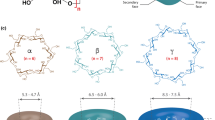Abstract
A series of hyperbranched poly(ester-amide-ether)s (H-PEAEs) were synthesized via the A2+CB3 approach by the self-transesterification of ethyl ester-amide-ethers end-capped with three hydroxyl groups and ethyl ester group at two terminals. The molecular structures were characterized with 1H NMR and FT-IR spectroscopy. The number average molecular weights were estimated by GPC analysis to possess bimodal wide distribution from 1.57 to 2.09. The strong inherent blue fluorescence was observed at 330 nm for excitation and 390 nm for emission. Moreover, the emission intensity and fluorescence quantum yield increased along with the incorporated ether chain length, as well as almost linearly with the H-PEAE concentration in an aqueous solution. For comparing the fluorescence performance, the linear poly(ester-amide-ether) (L-PEAE) and hyperbranched poly(ester-amide) (H-PEA) were synthesized. The results showed that the coexistence of ether bond and carboxyl group in the molecular chain was essential for generating the strong fluorescence. However, the compact backbone of H-PEAE would be propitious to the enhancement of fluorescence properties.
Similar content being viewed by others
References
Kuila BK, Garai A, Nandi AK. Synthesis, optical, and electrical characterization of organically soluble silver nanoparticles and their poly(3-hexylthiophene) nanocomposites: Enhanced luminescence property in the nanocomposite thin films. Chem Mater, 2007, 19: 5443–5452
Zheng J, Dickson RM. Individual water-soluble dendrimer-encapsulated silver nanodot fluorescence. J Am Chem Soc, 2002, 124: 13982–13983
Michalet X, Pinaud FF, Bentolila LA, Tsay JM, Doose S, Li JJ, Sundaresan G, Wu AM, Gambhir SS, Weiss S. Quantum dots for live cells, in vivo imaging, and diagnostics. Science, 2005, 307: 538–544
Gao C, Yan D. Hyperbranched polymers: From synthesis to applications. Prog Polym Sci, 2004, 29: 183–275
De Schryver FC, Vosch T, Cotlet M, Van Der Auweraer M, Müllen K, Hofken S. Energy dissipation in multichromophoric single dendrimers. J Acc Chem Res, 2005, 38: 514–522
Gao C, Hou J, Yan DY, Wang ZJ. Preparation and characterization of fluorescent hyperbranched polyether. React & Funct Polym, 2004, 58: 65–72
Gao C, Yan DY, Zhang B, Chen W. Fluorescence studies on the hydrophobic association of pyrene-labeled amphiphilic hyperbranched poly(sulfone-amine)s. Langmuir, 2002, 18: 3708–3713
He QY, Lai WY, Ma Z, Chen DY, Huang W. Novel blue light-emitting hyperbranched polyfluorenes incorporating carbazole kinked structure. Euro Polym J, 2008, 44: 3169–3176
Wu GL, Yang Y, He C, Chen XM, Li YF. A new triphenylaminebased hyperbranched polyfluorene with oxadiazole units on its side chains. Euro Polym J, 2008, 44: 4047–4053
Peng Q, Yan LS, Chen DZ, Wang FZ, Wang P, Zou DC. Synthesis and characterization of hyperbranched polyfluorenes containing triarylpyrazoline cores towards efficient blue light-emitting diodes. J Polym Sci Part A: Polym Chem, 2007, 45: 5296–5307
Pugh VJ, Hu QS, Pu L. The first dendrimer-based enantioselective fluorescent sensor for the recognition of chiral amino alcohol. Angew Chem Int Ed, 2000, 39: 3638–3641
Ji ML, Yang WL, Ren QG, Lu DR. Facile phase transfer of hydrophobic nanoparticles with poly(ethylene glycol) grafted hyperbranched poly(amido amine). Nanotechnology, 2009, 20: 075101
Liu CH, Gao C, Yan DY. Honeycomb-patterned photoluminescent films fabricated by self-assembly of hyperbranched polymers. Angew Chem Int Ed, 2007, 46: 4128–4131
Lee WI, Bae Y, Bard AJ. Strong blue photoluminescence and ECL from OH-terminated PAMAM dendrimers in the absence of gold nanoparticles. J Am Chem Soc, 2004, 126: 8358–8359
Wang DJ, Imae T. Fluorescence emission from dendrimers and its pH dependence. J Am Chem Soc, 2004, 126: 13204–13205
Wang DJ, Imae T, Miki M. Fluorescence emission from PAMAM and PPI dendrimers. J Colloid Interf Sci, 2007, 312: 8–13
Wu DC, Liu Y, He CB, Goh SH. Blue Photoluminescence from hyperbranched poly(amino ester)s. Macromolecules, 2005, 38: 9906–9909
Pastor PL, Chen Y, Shen Z, Lahoz A, Stiriba SE. Unprecedented blue intrinsic photoluminescence from hyperbranched and linear polyethylenimines: Polymer architectures and pH-effects. Macromol Rapid Commun, 2007, 28: 1404–1409
Kataky R, Nicholson PE, Parker D. Comparative study of mono- and di-substituted 14-crown-4 derivatives as lithium ionophores. J Chen Soc, Perkin Trans, 1990, 2: 321–327
Dayan I, Libman J, Shanzer A, Felder CE, Lifson S. Regulation of Molecular conformation of chiral tripodal structures by Ca2+ binding. J Am Chem Soc, 1991, 113: 3431–3439
Newkome GR, Baker GR, Arai S, Saunders MJ, Russo PS, Theriot KJ, Moorefield CN, Rogers LE, Miller JE, Lieux TR, Murray ME, Phillips B, Pascal L. Synthesis and characterization of two-directional cascade molecules and formation of aqueous gels. J Am Chem Soc, 1990, 112: 8458–8465
Li XR, Lu XF, Lin Y, Zhan J, Li YS, Liu ZQ, Chen XS, Liu SY. Synthesis and characterization of hyperbranched poly(ester-amide)s from commercially available dicarboxylic acids and multihydroxyl primary amines. Macromolecules, 2006, 39: 7889–7899
Shi WF, Ranby B. Photopolymerization of dendritic methacrylated polyesters. I. Synthesis and properties. J Appl Polym Sci, 1996, 59: 1937–1944
Albani JR. Principles and Applications of Fluorescence Spectroscopy. Oxford: Blackwell Science Ltd, 2007. 101–102
Lianos Bekiari PV, Stangar UL, Orel B, Judeinstein P. Optimization of the intensity of luminescence emission from silica/poly(ethylene oxide) and silica/poly(propylene oxide) nanocomposite gels. Chem Mater, 2000, 12: 3095–3099
Brankova T, Bekiari V, Lianos P. Photoluminescence from sol-gel organic/inorganic hybrid gels obtained through carboxylic acid solvolysis. Chem Mater, 2003, 15: 1855–1859
Carlos LD, de Zea Bermudez V, Ferreira RAS, Marques L, Assuno M. Sol-gel derived urea cross-linked organically modified silicates. 2. Blue-light emission. Chem Mater, 1999, 11: 581–588
Author information
Authors and Affiliations
Corresponding author
Rights and permissions
About this article
Cite this article
Zhang, Y., Fu, Q. & Shi, W. Synthesis and intrinsic blue fluorescence study of hyperbranched poly(ester-amide-ether). Sci. China Chem. 53, 2452–2460 (2010). https://doi.org/10.1007/s11426-010-4154-1
Received:
Accepted:
Published:
Issue Date:
DOI: https://doi.org/10.1007/s11426-010-4154-1




